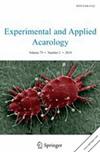以 Frankliniella occidentalis 的卵和幼虫为食的 Amblyseius largoensis、Amblyseius swirskii 和 Proprioseiopsis lenis(蛔虫:Phytoseiidae)的生命表参数。
摘要
在 25 °C、60% 相对湿度的受控实验室环境中,使用蓟马卵和西方花蓟马 Frankliniella occidentalis Pergande 的初生螨作为猎物,研究了捕食螨 Amblyseius largoensis (Muma)、Proprioseiopsis lenis (Corpuz and Rimando) 和 Amblyseius swirskii Athias-Henriot(螨类:Phytoseiidae)的未成熟发育和繁殖情况。与 A. swirskii(分别为 8.05 天和 7.19 天)和 P. lenis(分别为 8.10 天和 7.05 天)相比,当提供蓟马卵作为食物时,A. largoensis 雄虫(7.05 天)和雌虫(6.51 天)的未成熟发育期明显较短。Amblyseius largoensis 的产卵率(2.19 卵/雌虫/天)也高于 A. swirskii 和 P. lenis(分别为 1.79 卵/雌虫/天和 1.78 卵/雌虫/天)。此外,它的繁殖力最高(25.34 卵/雌虫),其次是 P. lenis(24.23 卵/雌虫)和 A. swirskii(22.86 卵/雌虫)。这些变化导致 A. largoensis 的内在增长率(rm)最高,为 0.209,其次是 A. swirskii(0.188)和 P. lenis(0.165)。然而,当向捕食螨提供 F. occidentalis 的初孵幼虫时,与 P. lenis(分别为 9.00 天和 7.86 天)和 A. largoensis(分别为 8.47 天和 8.61 天)相比,A. swirskii 雄虫(7.67 天)和雌虫(7.59 天)的未成熟发育期更快。虽然 P. lenis(1.92 卵/雌虫/天)和 A. swirskii(1.90 卵/雌虫/天)捕食这种猎物时的产卵率相似,但 A. largoensis 产卵较少(1.83 卵/雌虫/天)。此外,A. swirskii 的繁殖力最高(31.93 卵/雌),其次是 A. largoensis(25.71 卵/雌)和 P. lenis(23 卵/雌)。因此,A. swirskii 的蓟马初生态内增率(rm)最高(0.190),其次是 A. largoensis(0.186)和 P. lenis(0.176)。总之,我们的研究结果表明,就生活史参数而言,A. largoensis 在捕食蓟马卵时表现最佳,而 A. swirskii 在捕食移动的蓟马初生幼虫时表现最佳。这些对所研究的捕食螨物种的食性偏好和繁殖能力的深入了解,对它们在农业环境中作为生物防治剂防治蓟马的潜在用途具有重要意义。The immature development and reproduction of the predatory mites Amblyseius largoensis (Muma), Proprioseiopsis lenis (Corpuz and Rimando), and Amblyseius swirskii Athias-Henriot (Acari: Phytoseiidae) were investigated using both thrips eggs and first instars of the western flower thrips, Frankliniella occidentalis Pergande, as prey in a controlled laboratory environment at 25 °C and 60% relative humidity. When provided with thrips eggs as food, A. largoensis exhibited a notably shorter immature development period for both males (7.05 days) and females (6.51 days) as compared with A. swirskii (8.05 and 7.19 days, respectively) and P. lenis (8.10 days and 7.05 days, respectively). Amblyseius largoensis also displayed a higher oviposition rate (2.19 eggs/female/day) than A. swirskii and P. lenis (1.79 and 1.78 eggs/female/day, respectively). Moreover, it exhibited the highest fecundity (25.34 eggs/female), followed by P. lenis (24.23 eggs/female) and A. swirskii (22.86 eggs/female). These variations led to A. largoensis having the highest intrinsic rate of increase (rm) at 0.209, followed by A. swirskii at 0.188, and P. lenis at 0.165. However, when the predatory mites were provided with first instars of F. occidentalis, A. swirskii demonstrated a faster immature development period for both males (7.67 days) and females (7.59 days) as compared with P. lenis (9.00 days and 7.86 days, respectively) and A. largoensis (8.47 days and 8.61 days, respectively). While the oviposition rates of P. lenis (1.92 eggs/female/day) and A. swirskii (1.90 eggs/female/day) were similar when feeding on this prey, A. largoensis produced fewer eggs (1.83 eggs/female/day). Further, A. swirskii exhibited the highest fecundity (31.93 eggs/female), followed by A. largoensis (25.71 eggs/female) and P. lenis (23 eggs/female). Consequently, the intrinsic rate of increase (rm) on thrips first instars was highest in A. swirskii (0.190), followed by A. largoensis (0.186), and P. lenis (0.176). In summary, our findings indicate that in terms of life history parameters A. largoensis performs optimally when feeding on thrips eggs, whereas A. swirskii performs best when preying on the mobile first instars of the thrips. These insights into the dietary preferences and reproductive capabilities of the studied predatory mite species have important implications for their potential use as biological control agents against F. occidentalis in agricultural settings.

 求助内容:
求助内容: 应助结果提醒方式:
应助结果提醒方式:


